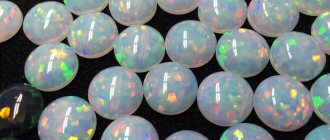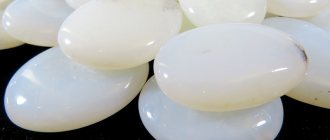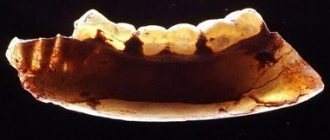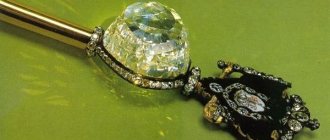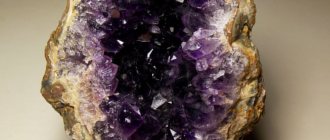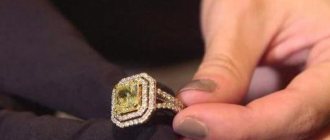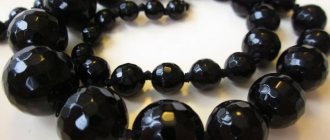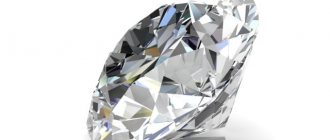How wonderfully precious opal plays!
It has the shine of the sun and the ebb of the moon.
It seems like there is a variable flow of life in it
And the quiet beauty of the silence of the night...
P.L. Dravert
The most interesting description of an unusual gem was found in the book “The Secret of the River of Evil Spirits.” It was written by a geologist in love with stones. You can learn a lot of interesting things about gems and how they are formed from a fiction (!) book for teenagers.
This is a description of a noble Brazilian opal.
“At first glance, it is a small light gray stone, so inconspicuous that if you come across it on the road, you will be too lazy to bend down (pick it up). And in this stone... in its depths, bright, clean lights lit up. Red, blue, green... The stone didn't just glow. It was burning with multi-colored lights. The illusion was so strong that everyone who took it in their hands involuntarily touched their fingers to ... the place from which the lights were breaking out to make sure that it was not heated.”
Opal: legends and myths
There are many of them among different nations.
Australia, rich in opals, believes that gems are traces of the Creator of the World.
In India they will tell you a myth about a woman who was running away from being pursued by a man. She ran away, tripped, fell... No, she didn’t lose consciousness. But when it fell, amazingly beautiful stones scattered from it.
Ancient Greek tale. When Zeus and his sisters and brothers pushed their daddy Kronos off the throne (there was a reason), Zeus burst into tears of happiness. Tears fell to the ground and turned into rainbow stones.
Consultations with historians did not confirm this version. There is no myth about opal and the tears of Zeus.
But there is this ancient Greek myth: Kronos was predicted that he would be overthrown by his own children. So he decided that the appropriate solution would be to swallow the kids. The Stone of Zeus, according to one myth, is the same stone that Kronos swallowed instead of the newborn Zeus. And Rhea’s wife slipped the stone into the diapers (Oops, Ops). The poor goddess is tired of giving birth to children and giving them to her heartless husband to feed.
I recommend watching the video about the secrets of opal.
Why opal?
It is generally accepted that the name may have come from "upala" (Sanskrit) - stone.
“ Enchanting sight ” - this is how the name of the gem is translated from Latin.
Pliny the Elder believed that the name is related to Ops - the goddess of fertility, the wife of Saturn (among the Greeks Kronos), the ancient Roman god of agriculture. God was stern and often ate his children. Some of the Saturnalia (festivals in honor of Saturn) were dedicated to Ops and were called “Opalia”.
Informative: some rituals from the Saturnalia are repeated in Christian Christmastide.
The Indians, with their ardent love for stones, were the first to notice opal. From India the gem came to Europe.
Interesting: NASA reported in 2008 that opals had been found on Mars.
How to distinguish a fake?
Very often, opal is imitated, replacing it with opalescent glass that can refract light, interspersed with special flakes to enhance the play of rays. A fake can only be accurately determined in a laboratory. However, professionals are able to conclude with a high degree of probability that the opal is artificial if:
- its iridescence is too sharp, monochromatic, without smooth transitions from one shade to another;
- there is no clear zoning of tones;
- opal does not cast small light “splashes”;
- it contains microcracks with air.
Very often opal is imitated, replacing it with opalescent glass capable of refracting light, interspersed with special flakes to enhance the play of rays
The stone is artificial if its iridescence is too sharp, monochromatic, without smooth transitions from one shade to another
The authenticity of a stone can only be determined in a laboratory
Advice! Many experts claim that if you touch a pebble with the tip of your tongue, the fake will not stick to it. Natural stone will not react to saliva in any way.
Physics and chemistry of gems
The opal mineral is a silica hydrogel. Contains up to 10% water (sometimes more).
The difference in color of multi-colored stones is due to the presence of impurities:
- iron;
- manganese;
- nickel.
Physical characteristics of the gem:
- can be transparent to almost opaque;
- pearlescent, glass luster;
- hardness from 5.5 to 6.5 on the Mohs scale;
- color from colorless, milky white, yellow, red, green, black.
Depending on the color, some types of stone are given their own names.
| Color | Colorless, white, yellow, red, brown, blue |
| Stroke color | white |
| origin of name | from the ancient Indian upala - precious stone |
| Opening year | known since ancient times |
| IMA status | valid, first described before 1959 (before IMA) |
| Chemical formula | SiO2+H2O |
| Shine | glassy, greasy, waxy, pearlescent, dull |
| Transparency | transparent, translucent, opaque |
| Cleavage | not visible |
| Kink | conchoidal, uneven |
| Hardness | 5,5 — 6,5 |
| Thermal properties | Under the blowpipe it cracks a lot, but does not melt. |
| Luminescence | yellow-green (uranyl) |
| Strunz (8th edition) | 4/D.01-80 |
| Hey's CIM Ref. | 7.8.8 |
| Dana (8th edition) | 75.2.1.1 |
| Molecular weight | 87.11 |
| Density (measured) | 1.9 — 2.3 |
| Pleochroism | does not pleochroate |
| Refractive indices | nα = 1.400 – 1.460 |
| Optical relief | moderate |
| Selection form | kidney-shaped, collomorphic cluster-shaped, stalactite sinter aggregates, deposits, nodules, geodes, solid masses, pseudomorphs of organic remains and some minerals |
| Classes on taxonomy of the USSR | Oxides |
| IMA classes | Oxides |
| singonia | amorphous |
| Fragility | Yes |
We recommend: Sunstone YELLOW TOPAZ
Precious opals are valued most highly. An indispensable property of the noble opal stone is the rainbow play of color highlights in the gem.
Opalescence
A little more physics. Gemologists usually call opalescence the effect of iridescence.
A rare and beautiful phenomenon. It is found in noble opals, mother-of-pearl, labradorite and pearls.
The name comes from the iridescent play of light of noble opal. It arises as a result of the heterogeneity of the structure of the mineral. Microscopic inclusions (globules) of cristobalite cause reflection and interference of light. That's the whole secret of the extraordinary rainbow play of color highlights.
How much does opal cost?
In jewelry, there is such a term as “opalescence” - a pearlescent or iridescent glow that occurs when light hits a stone. The cost of opal depends on how spectacular this stone is and what colors it shimmers. The exception is fire opal and chrysopal, the price of which depends only on their color and transparency.
Depending on the type of opal, its cost can vary from a few cents to several thousand dollars per carat:
- precious (noble) : a stone is considered precious if it has a rainbow play of shades in the complete absence of colorless areas; stones with ideal characteristics are very rare and are valued at up to 5 thousand dollars per carat; gems with contrasting tints of cold fire are considered standard;
- ordinary: outwardly inconspicuous, do not have an optical effect and therefore are of no commercial interest; when mined, they go to waste.
A stone is considered precious if it has a rainbow play of shades with a complete absence of colorless areas
Stones with ideal characteristics are very rare and are valued at up to 5 thousand dollars per carat
Gems with contrasting tints of cold fire are considered standard
Advice! The price of an opal stone (see photo) is also influenced by the type of cut. Unlike diamonds, which have 17 to 57 perfectly polished facets, opals have a smooth, domed or round shape with no edges. This type of cut is called cabochon.
Large family of opals
Australian scientist F. Leekhman counted 134 varieties of opal.
Mineralogists try to classify opals based on transparency, color, brilliance, and hardness.
The opal family is large, branched, there are many “step-relatives” in it, and there is also a frank “seventh water on jelly”.
The most valuable are noble opals. Those that have a play of light, iridescence.
There are several varieties of noble opal:
- Black opal. The stone can be not only black, but also dark gray. These gems are found very rarely. And their cost is not at all affordable. The most interesting of the black opals is “harlequin”. Red, blue, orange, yellow lights flash in it. The pebble resembles the robe of Harlequin, a puppet theater character, sewn from multi-colored scraps. Harlequins are often called Ethiopian opal.
- White opal . The color is not always milky; there is yellow, light gray. The base of the stone is translucent. Fine white opal always opalescents. Some can be confused with adularia.
- Crystal opal . Can be dark or light. But always transparent, opalescent.
- Hyalite. The stone is transparent, colorless; but occasionally you come across specimens with faint shades of color (yellow, blue, green).
- Fire opal. Color ranges from amber to golden red. Mexican fire gems often have an iridescent play of light. But if the stone does not have opalescence, then it is not a noble opal, but a simple one.
- Girazol can be blue or white, almost or completely transparent. Its “zest” is the red, yellow, blue sparks that flare up in the depths of the stone.
One of the largest opals found is Brazilian, weighing 4.3 kilograms.
White opals differ from moonstone in their iridescence. Opal does not have the "cat's eye" effect often associated with adularia. And the iridescence of the stones itself varies: in moonstones it is partial, while opals iridize almost the entire body of the stone.
Simple opals
Common opal. It lacks play of color and iridescent tints. The stone is considered semi-precious. This group includes:
- Pearl opal . Almost opaque pearly white gems. Occasionally there are color inclusions in the stone.
- Wax opal . Honey, yellow, wax-colored gem.
- Dendrite opal was formed from prehistoric trees. In the dead trunks, iron material was replaced by minerals. This process is possible when the fallen tree has been covered (preserved) by sedimentary rocks or volcanic ash. The color of dendritic opal is often gray or brownish. But there are red, pink, blue and purple ones.
- Blue (Peruvian) opal . An opaque gem of blue, cyan, blue-green, and sometimes pinkish shades. There is no pleochroism.
- Cacholong. A porcelain-shaped gem of a milky white color with a pearlescent sheen. It has light shades of grayish, yellowish, reddish color.
- Hydrophane, water opal. The cloudy stone literally comes to life when it is lowered into water. It begins to play with opal highlights and becomes more transparent.
There are countless types of opals. But each of them is good in its own way.
Contra luz opal. The rarest stones with the effect of internal 3D paintings. It is impossible to describe what paintings in stone look like; you have to see them.
Lechos opal plays with all shades of green. Tanzanian gems often have a cat's eye effect; Peruvian lechos opals in pastel shades with a blue tint. Australian ones are the most expensive. They are dark (sometimes called black), with a beautiful play of light.
We recommend: Obscenely expensive GREEN DIAMONDS
Noble opals and Mexican fire opals are classified as precious stones.
Simple opals, depending on their beauty, can be classified as semi-precious and ornamental stones.
Types of opals
It is difficult to count the varieties of opal; such a riot of color and patterns is no longer found in nature. Descriptions of different gems can be found in ancient mythology; special properties were attributed to each specimen.
Varieties of opal species:
- Black is considered the rarest and most expensive, and dark blue and purple opals are also found.
- Fire opal is found in Mexico, the palette ranges from honey-yellow to rich hyacinth shades, and has a subtle pearlescent sheen.
- Varieties of opal include amazing pearl gems, specimens are opaque, there are various inclusions, similar gems are found in Kazakhstan.
- Blue - the description of the stone corresponds to sea blue, the incredibly bright saturated color can be confused with artificial, the peculiarity is the ability to change color from soft blue to dark blue.
- Green opal is the most popular among collectors; it is opaque, similar to jade, but the color scheme is brighter and the patterns are contrasting.
- Whatever shade you can find in the opal family, there are even waxy gems similar to amber.
Video: Living Gemstone
Gems deposits
Precious opal is mined on an industrial scale in these countries:
- Ethiopia;
- Hungary;
- USA;
- Hungary;
- Czech Republic;
- Slovakia;
- Mexico;
- Brazil;
- Kazakhstan;
- Türkiye;
- Honduras.
In Russia there are also deposits of multi-colored stone miracles.
Hyalite is mined in the Nerchinsk region, fire and wax opal - in Kamchatka.
You can find opals in Altai and the Orenburg region.
Australia holds the lead in the volume of production of opal stones. Then come the Brazilian and Ethiopian deposits.
If you ask, what significance do rocks containing beautiful stones have for people, we will answer honestly. None yet. Only mining of beautiful stones to decorate women, and sometimes men.
Where is it mined?
Most often, stone deposits look like biconvex lenses or veins in the thickness of other rocks. Large deposits are rarely found. Today, the main supplier of gems is Australia. The reason here is not only because of particularly large reserves, but also because opal mining has been going on for a very long time. Intensive development led to the fact that the mines in Europe, Asia and northern Africa were almost completely exhausted by the 19th century.
Approximately 90% of Australian gems are white crystals of varying transparency. The “capital” of stone mining is the city of Coober Pedy, South Australia. In the state of Queensland there are deposits of the boulder class mineral. And finally, the village of Lightning Ridge in New South Wales boasts a deposit of the rarest black specimens.
The leader in the production of these gems is Australia.
Other countries also supply the market with unprocessed opal, although in much smaller quantities. Gem deposits outside the kangaroo continent are known in the following countries:
- Mexico (Yucatan Peninsula);
- Honduras;
- Guatemala;
- Peru;
- United States of America, Nevada;
- Japan;
- Slovakia;
- Türkiye;
- Kazakhstan.
Fire opals, one of the rarest varieties of gemstone, are sometimes found in these countries. Stone is also found in Kamchatka and Transcarpathian Ukraine, but full-scale development of deposits in these regions is not carried out.
The capricious magic has fallen
Some peoples considered opal “the stone of false hopes.”
The magical properties of opal - as has long been believed - are as changeable as the play of light in it. A gem can keep the same person from base passions, or push him onto the path of forbidden pleasures.
- Opal loves a gold setting. Esotericists are sure that the influence of a stone is enhanced when it is set in gold.
- White opals will give harmony with the world and the ability to empathize with loved ones.
- Black opal is suitable for magicians; it gives the ability to foresee the future. It can also push the owner onto the path of base pleasures.
- Eastern peoples considered the gem an amulet that protected love and happiness.
- The gem has long been used as a talisman against the evil eye and astral attacks.
- Europe treated stone differently. At first he was a favorite of rich people. But over time, the poor gem fell into the category of “unreliable”.
Informative: in the 19th century, the novel “Anna of Geierstein, Maid of Darkness” was published. The novel quickly became a bestseller. And it is written in the novel about an opal that brought trouble to its owner. Impressionable readers turned away from the stone. Sales of the gem collapsed.
Opal will be a good talisman for talented, creative people. This does not necessarily mean being a person of art; a shoemaker or a tailor can be talented.
The gem will help only those who are not obsessed with a passion for profit, anger and envy of more successful people.
The moon strengthens its influence on the gem on the 11th, 13th, 18th days of the lunar cycle.
Who is opal harmful to?
The magic of the gem will not benefit business-minded, down-to-earth people.
If you have an “explosive character,” the gem is not for you.
If neighbors and loved ones are ready to rejoice in misfortune, do not wear the stone. For you, he will be a provocateur of quarrels, suspicions, and fears. Including fear of the dark.
Magic properties
The meaning of opal in the magic of gems is the revelation of a person’s internal reserves, the realization of the wearer’s most hidden passions and desires. Only strong-willed, creative and resourceful people will be able to find harmony with the mineral. For others, it will become just another decoration.
The mineral is able to protect its owner from negative energy, the evil eye, damage and love spells.
The stone also reveals the gift of foresight and enhances intuition. But only people with pure thoughts should wear it. The fact is that the crystal enhances all the emotional impulses of the owner. Black opal is especially famous for this. This gem is capable of drawing out the most hidden aspirations from the depths of the subconscious, but is also considered the most powerful amulet.
The mineral has a strong protective effect against the evil eye, poison and other evils.
White stones have a completely opposite character. These are the best amulets for healers, nurses and nannies. They enhance good character traits and make the wearer more tolerant and calmer. Blue and blue opals can strengthen marriage and friendship, protect against failures and temptations.
Fire stones affect women and men differently. Representatives of the stronger sex under its influence will become braver, more decisive and tougher. The fair half of humanity will notice that the crystal has made them wiser, calmer and more tolerant. The gem will help you find a couple for a serious relationship and achieve reciprocity. The magical properties of opal are also used in rituals aimed at attracting money, good luck, and happiness in your personal life.
What does a gem cure?
The East unconditionally gave opal the palm in healing from all diseases. Patients used a ring with a gem; it was supposed to be worn on the index finger of the right hand.
Unverified: there is a belief that opals lose their shine and opalescence before the owner becomes seriously ill.
Now esotericists divide the healing properties of opal according to its type and color:
- Pink gem will help with diseases of the cardiovascular system. Normalizing blood pressure and relieving swelling - these are the “professional” capabilities of the stone.
- Blue opals are responsible for the mental health of the owner. A heavenly-colored opal will help calm your “unhinged” nerves and normalize your emotional state.
- Green gems will help you hear and see better. To do this, massage the line between your eyebrows with a stone at least once a day.
- All noble opals, as lithotherapists say, normalize the functioning of the gastrointestinal tract and improve metabolism. As a result, they will help you lose a few extra pounds.
A gem amulet is useful for older men.
To treat infectious and heart diseases, water infused with opal is used.
It is not advisable to wear opal jewelry all the time.
Do not forget that the stone will not replace a doctor, but will only help in treatment.
Medicinal properties
Opal is used to treat diseases of the cardiovascular system and nervous disorders.
Opal stone has been used to treat many diseases since ancient times. Thus, it was believed that it was able to neutralize poisons, stop bleeding, and protect against plague. Lithotherapists of our time use all varieties of the mineral in the following areas:
- Normalization of the emotional background. Peruvian and heavenly minerals are excellent talismans for meditation. They are able to heal anxiety, nervousness, and normalize sleep. All precious varieties help get rid of depression and melancholy.
- Treatment of diseases of the cardiovascular system. Pink or red opal will help for this. To normalize blood flow and blood pressure, reduce the development of atherosclerosis and the frequency of angina attacks, you need to wear a bracelet with a stone on your left wrist.
- Improved vision. Massaging the eyebrows with a green gem helps get rid of eye fatigue and spasm of accommodation.
- Treatment of diseases of the gastrointestinal tract. Precious varieties of stone relieve symptoms of stomach ulcers, gastritis, relieve nausea, heartburn and heaviness in the abdomen.
Separately, it should be said about fire opal. It is difficult to overestimate its importance for a person who is weakened after a long illness or suffers from chronic fatigue. Meditation on the flames in the depths of the stone helps to restore vigor, increase efficiency, and relieve irritability after a hard day.
Rainbow Stone Astrology
Astrology considers opal to be the birthstone of October.
The patron planet is the Moon, some astrologers are sure that different types of opals are also ruled by Neptune and Pluto.
We recommend: LEUCOSAPPHIRE - the modest charm of a gem
Many astromineralogists are sure that opal is suitable for any zodiac sign. It is important to choose the right type of stone.
- Red and fire opal are suitable for fire signs. This is especially true for Aries and Leo.
- Pisces is ideally compatible with transparent opals.
- Scorpios - your stone is black opal.
- Cancers and Libras can benefit from wearing precious jewelry.
- According to the horoscope, green and black opals are suitable for Taurus and Capricorn.
Recommendation from astromineralogists: wear a ring with an opal on your middle finger, and during the day put the stone on the middle finger of your left hand, then on your right, 2-3 times.
Compatibility of opal according to zodiac signs
The properties of opal for Scorpio will be revealed 100%. In any business that a person with such an “assistant” undertakes, he will be able to achieve success. The stone will protect Scorpio from evil spirits and any negative influence.
A gem of any color is suitable for Pisces. But there are times when the stone has a negative effect on the mind of representatives of this sign. In this case, wearing the stone must be stopped for a certain time, after which the opal can be used again.
Gems of red tones are recommended for Capricorns and Virgos. The stone develops hidden potentials in people. Light tones of opals can make Gemini and Virgo more calm, and stones of fiery tones will awaken activity in them. For Aquarius and Taurus, blue-hued minerals will be suitable talismans. Cancers are recommended to wear black gems.
Opal is contraindicated for all fire signs except Sagittarius. Representatives of this sign are an exception to this rule and can safely wear opal. In terms of energy, this stone is not suitable for Aries and Leo.
Only natural stones have healing and magical properties. Artificial gems do not have the real power and beauty of opal. It's just a decoration. Happiness and good luck will be brought only by natural transparent stones, which have clear boundaries and reflect hundreds of amazing reflections.
Patent and common counterfeits
The first patent for the production of synthetic opals was received by researchers Gaskin and Dorre (Australia). At the end of the 18th century, imitation gems began to be produced on a commercial scale in Switzerland. Their prices are several times lower than for natural ones, and it is quite difficult to distinguish a fake. In the last century, with the advent of nanotechnology, methods for creating stones with opalescence appeared.
It is now difficult to distinguish a natural gem from a fake. But you can try:
- A synthetic stone does not provide that magical play of light - the opalescence that occurs precisely in the depths of the gem.
- Imitation is always brighter, catchier, and more vulgar in color.
- Doublets and triplets can be identified using a magnifying glass - it will help identify the joints, seams between the natural opal plate and the base.
Important: painting white opals black and impregnating stones with synthetic resins is considered a fake.
Trade in doublets and triplets is allowed in jewelry stores. They cannot be called real stones, but they are not completely fake.
A doublet is a thin plate of a gem glued to an opaque base.
A triplet consists of three parts. The “lid” is made of transparent quartz, the opal plate and the backing are made of opaque material.
Opal cut
The presence of facets in opal is not welcome. Since its most valuable quality is the play of color, it is cut only with a rounded cabochon so that the entire surface of the stone is even and smooth. It is this treatment that allows the stone to fully open up and sparkle with colors.
Most often, the cabochon is made round; its oval or oyster shell shape is less common. High domes are more preferable for crystal stones. Black opals are always flatter.
Most often, the cabochon is made round; its oval or oyster shell shape is less common.
High domes are more preferable for crystal stones
Black opals are always flatter
Sometimes, to lighten a low-transparent stone, its surface is made slightly concave. There are also so-called double cabochons with a convex lower part, with the help of which the color saturation is enhanced. The glow of such stones is similar to the glow of a gem.
Fiery specimens are made almost flat or slightly convex. Stones inserted into earrings, brooches or pendants also have a flatter surface. The convex shape is used for opals intended for rings.
Sometimes, to lighten a low-transparent stone, its surface is made slightly concave
Fiery specimens are made almost flat or slightly convex
Stones used in earrings, brooches or pendants also have a flatter surface
Advice! Typically, to avoid loss of stone, opals are processed in a free form. However, more expensive are perfectly symmetrical specimens without chips, cracks, stains or dull areas.
We take care and protect your favorite jewelry
Gems are easy to damage; they are real “Princesses and the Pea”.
Caring for a capricious stone:
- Products with opal should be stored separately from other jewelry.
- Some types of stone are able to absorb (“draw in”) the liquid in which they are immersed. Do not give your decoration baths made of dirty water, ink, or colored liquids. This can irreparably damage the gem.
- The quality of the stone can easily be spoiled by contact with fats and oils.
- If a stone loses water, it becomes cracked, loses color and play of colors. Therefore, special conditions are required to store opal jewelry. Give him a separate box, a casket, and keep a piece of a damp sponge there along with the decoration.
- Ultrasonic and steam cleaning are excluded unless you want to kill the stone.
Important: opals are afraid of sudden changes in temperature. Bathing procedures and winter swimming are contraindicated for such sissies.
The gem is afraid of alkalis. Therefore, you cannot wash it with soapy water and (God forbid) soak in a bubble bath with the stone, but you cannot wash the dishes.
Ring with opal
Application and care
Products made from opal are as diverse as the mineral itself. Jewelry is made from noble varieties by setting them in precious metals. Cheaper stones are also used for rings and bracelets. Ornamental varieties become material for figurines, tabletops and vases. The cheapest subspecies are used to make facing tiles.
To ensure that your stone lasts as long as possible, you must remember that opal is one of the most fragile minerals. The thing is, it's not even a crystal in the scientific sense. Each specimen consists of tiny globules, which are welded together extremely weakly. However, if you follow simple wearing rules, then nothing bad will happen to the gem.
- The stone must be protected from impacts, shocks and friction.
- If you need to clean opal jewelry, use soapy water and a soft toothbrush. After removing dirt and dust, wrap the gem in a napkin and leave in a sunny place for an hour.
- Do not keep the mineral in direct sunlight for a long time. It may lose color or even crack. If this happens, immerse the stone in water at room temperature for a couple of hours.
- Remove rings and bracelets when you start cleaning. Contact with detergents, especially alkaline ones, can cause irreparable damage to the crystal.
- Keep your jewelry wrapped in soft cloth in a cool, dark place.
A careful attitude is the main condition for “tuning” your opal to the right wave. The magical properties of a mineral that is in harmony with your soul will be maximum.
Who and what is jewelry suitable for?
The variety of colors plus iridescence or dullness make opal universal.
Appearance type
Opal jewelry is chosen to match the eye color:
- blue eyes - blue or blue opals;
- brown – red and green;
- gray – blue tones;
- green – purple and green stones.
Accessories with white and black opals suit everyone.
Red or fiery opal will decorate people with a winter color type (with contrast between hair and skin).
Fire Opal Ring
Gems in matte or opaque shades are suitable for other options.
Monochrome jewelry goes with any clothing in pastel or rich muted colors, multi-color iridescent opals - with monochromatic ones.
Time of year and day
Accessories with opals are appropriate all year round:
- For a sea cruise or winter wardrobe, jewelry with blue opals or rich blue ones is suitable;
- in summer they wear sparkling multi-colored silver pendants, earrings, a necklace, and a bracelet to match the dress (preferably silk);
- in autumn - sparkling yellow-brown or purplish-red opals;
- for a party or bachelorette party, a pendant or pendant made of gold with opal is suitable;
- for the office, choose small silver earrings or a ring; a business suit will make a silver brooch more feminine;
- An option for the lady boss is white Australian noble opal in platinum or gold.
Opal jewelry is equally good with casual, office or dressy clothes, shiny or embroidered with rhinestones.
Place of Birth
Opal
Opal is often found in thin layers or flat lenses, large pieces are rare. It is found on all continents, but Australian deposits account for, according to some statements, about 97% of all world production. Of these, 90% are called “light opals” or white crystalline opals.
Most Australian opals are mined in Coober Pedy in South Australia. The boulder type is mined in the state of Queensland. One of the largest mines producing this type of mining is Jundah. In the state of New South Wales, in the area of the town of Lightning Ridge, another opal with a predominant black color is mined (with a play of colors from dark gray to black-blue). This type is considered the rarest, as black opal accounts for only about 5% of the total opal mined in Australia. Opal is considered the national stone of Australia.
In addition to Australia, Ethiopia is a major exporter of opals. Most of the precious opals are mined in Australia, Mexico, Brazil, Guatemala, Honduras, Japan, Slovakia, the USA (Nevada), with minor occurrences in Russia (Kamchatka) and Ukraine.
Ordinary and fire opals are often found in Mexico (states of Hidalgo (state) and Queretaro), Brazil, Guatemala, Honduras, USA, Turkey, Kazakhstan.
This is interesting!
In late 2008, NASA announced that it had discovered opals on Mars.
The magic of jewelry
The main metaphysical property of the gem is considered to help in assessing specific periods of life. Opal gives an almost instantaneous understanding of events, the meaning of which under normal conditions is comprehended only years later. But this is not its only useful quality.
Therapeutic effect
Lithotherapists widely use the capabilities of opal. Jewelry with it solves the following problems:
- earrings – vulnerability of the central nervous system, reduced resistance to stress;
- necklace, brooch – heart disease, gastrointestinal tract;
- bracelet – muscular system (tics, cramps);
- pendant – infections;
- earrings – vision; you can contemplate a pebble;
- ring - potency.
Opal normalizes the functioning of the pituitary gland and pineal gland. To make the effect stronger, choose an accessory closer to the problem area.
Magic properties
The magical properties of opal are used by the official church, sorcerers and ordinary people. For residents of South America, this is a channel of communication with other worlds; in Europe, it is an attribute of the ladies of the demimonde.
The color of the opal in the jewelry matters:
- white - decorations make a person correct, virtuous, patient, forgiving; protect from moral failures;
- black is the stone of magicians and sorcerers; in others it sharpens the mind, but awakens vices; the owner of black opals will have to balance on the brink, problems await the weak-willed;
- blue is the best helper on the way to the goal; the owner becomes a clairvoyant (especially with a purple stone);
- fiery – in men it shows strength, confidence, self-sufficiency, and other masculine attributes; in women – female (also yellow Ethiopian opal).
Brooch with blue opal
The magical properties of the gem help purposeful people: if a person grabs everything at once, the opal is useless or dangerous.
Esotericists advise wearing a gold ring with an opal on the middle finger, alternately on both hands during the day. Gold increases the magical capabilities of opal.
The stone senses the moral state of the owner and loves to be with him. But taking a break from each other won't hurt.
Zodiac
Opals are suitable for all zodiac signs; the type and color of the jewelry insert matters:
- Pisces - any;
- Scorpio – black;
- Taurus - everything except black and dark;
- Aquarius – black;
- Gemini - any twinkling;
- Libra – red;
- Virgo, Capricorn – fiery;
- Cancer – red, black.
The stones are energetically incompatible with Sagittarius, Aries, and Leo. As a last resort, choose white or blue opal. They suit all signs. The main thing is that the owner of the jewelry believes in himself.
Products with synthetic opal can be worn by any zodiac sign.
| Zodiac sign | Compatibility (“+++” – fits perfectly, “+” – can be worn, “-” – strictly contraindicated) |
| Aries | — |
| Taurus | + |
| Twins | + |
| Cancer | + |
| a lion | — |
| Virgo | + |
| Scales | + |
| Scorpion | +++ |
| Sagittarius | + |
| Capricorn | + |
| Aquarius | + |
| Fish | +++ |
How to identify a fake
Almost all opal jewelry is equipped with artificial inserts, but manufacturers do not always report this.
Price is a reliable guide. Gold ring or earrings with opal for 8-10 thousand rubles. – fake.
The following signs help determine the origin of the stone:
- natural opal is unevenly colored, the surface pattern is chaotic; the fake is uniform, with an orderly pattern, garishly bright;
- in intense lighting, the opal glows from below, allowing light to pass through; if the sample is not translucent, dust particles or stains of dirt are visible inside, this is an imitation;
- synthetics have a clearly defined “scaly” appearance, created to imitate opalescence; but the reflections and tints are monochrome and sharp, in a natural gem - with a soft change in shade;
- sunlight passing through the opal creates a rainbow; synthetics are not capable of this;
- If you touch the fake with your tongue, it will stick.
Natural opals
A fake can be easily distinguished by its substrate. If it is black or dark blue and neatly glued, then it is not opal. This is how doublets or triplets are made - a combination of low-grade opal with plastic, quartz and iron ore.
Rules for choosing a mineral
Fraudsters sometimes pass off ordinary pieces of glass as opals, so you need to be careful when choosing jewelry. When purchasing a stone, the main thing is to evaluate its value on its merits. Buying a copy from a laboratory or a fake is not as scary as it is dangerous to overpay for it. Therefore, when choosing opal, you should be guided by the following rules, and also take into account the differences in stones:
- It is important to find out about the origin of the specimen. This fact is confirmed by special documents that the seller must have. Or you can conduct a gemological examination and find out the authenticity.
- Artificial opal emits only one color, while real stones play with many colors. The sameness of stone patterns should also alert the buyer and tempt them to believe that the stone is of artificial origin.
- A real stone casts glare on a person’s fingers, unlike an artificial one.
- An artificial stone will stick to the tongue, whereas a real one will not.
When choosing opal, be guided by your budget and your own taste. There are no special restrictions when wearing the stone. It’s just that opal doesn’t like being in proximity to other minerals, so it’s better to carry the stones separately. When choosing a noble opal, the cost of gold or other precious metal does not play a special role. Ordinary opals can even be found in jewelry, which reduces the cost of the product.
Opal is an interesting stone, and its varieties can satisfy every taste and budget. Therefore, choosing an opal is a pleasant time in a jewelry store. The main thing is to combine the mineral with your style.

